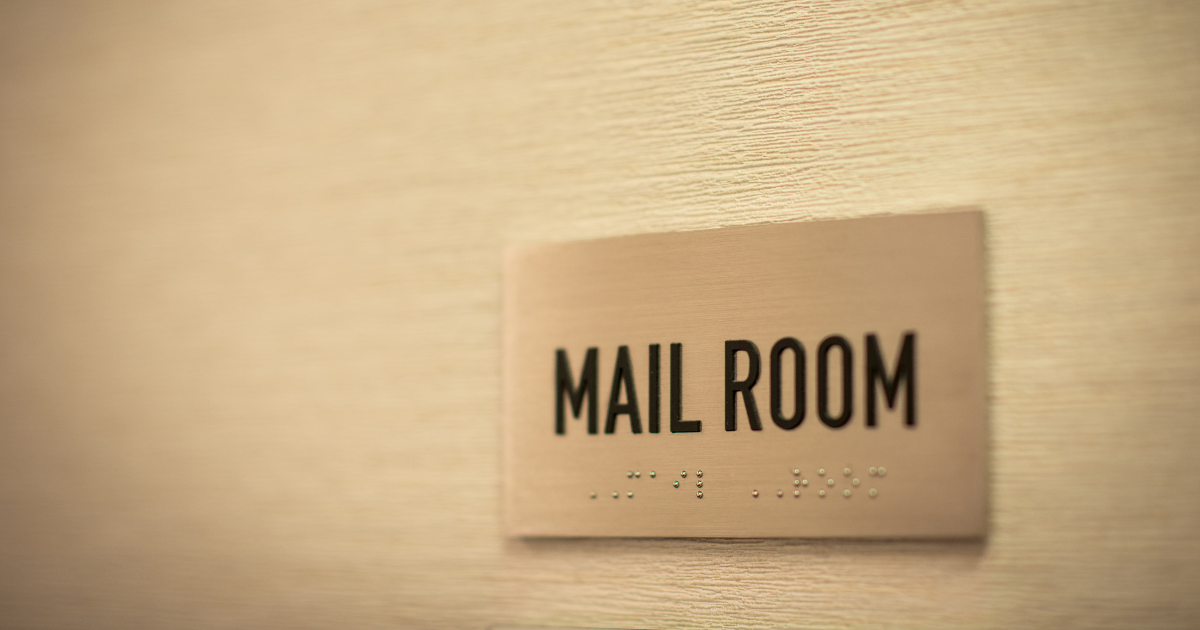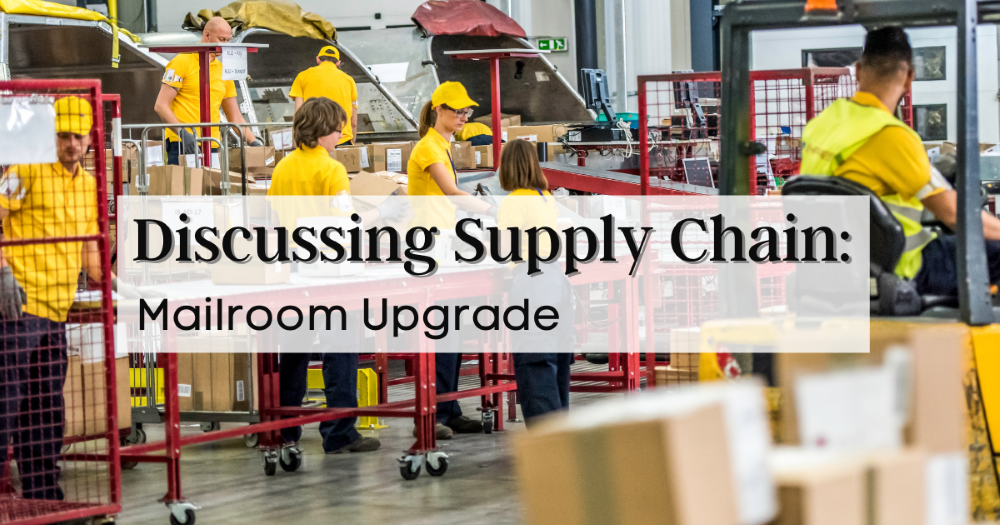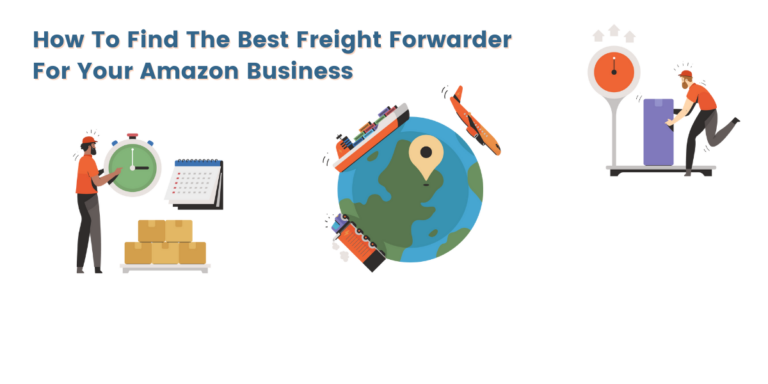Let’s Discuss Supply Chain: Is an eCommerce boom forcing property owners to upgrade their mailrooms?
The rapid boom of eCommerce
The rapid eCommerce boom has forced brands to upgrade their mailrooms. Ecommerce is a subset of online retail that involves buying and selling goods or services over the Internet, usually via a website. Online retail has flourished over the last decade and created an eCommerce boom dominating today’s business model.
Since online retailers don’t need physical space to store inventory, they can take up less space in a city and offer more selection.
In recent years, companies have been forced to move from an offline model where goods were shipped by trucks to factories or warehouses with the company’s logo on the side to an online model, where goods are shipped through the mailroom.
eCommerce shopping has become more popular in recent years because of its convenience and affordability. As a result, retailers have had to adjust their business models to keep up with the boom.
What is the eCommerce boom?
The eCommerce boom is a change in the demand for goods and services. In the United States, personal protection, home activities, groceries, and ICT equipment increased while demand for travel, sports, and formal clothing decreased. The US has seen an increase in online shopping and neighborhood businesses with brick-and-mortar stores closing due to this eCommerce boom.
The boom in eCommerce has been a boon for sellers and consumers, but it can be disruptive. For example, the surge in demand for disposable gloves forces retailers to invest more heavily in their supply chain management. In addition, the increased need for these items puts pressure on mailrooms that don’t offer them at all or have limited quantities at any given time.
When the eCommerce boom happened, the need for property owners’ mailrooms increased. These upgrades are necessary because of the high volume and different shifts that come with this shift in a business model. This is a valid concern as digital data has become more accessible over time through technological advancements such as cloud computing, internet penetration rates increasing from 24% to 64%, and sales growth rate by 2%.
With an eCommerce boom, more companies are investing in property upgrades to handle the increased delivery volume of online orders. The investments made by these businesses include upgrading their mailrooms and equipment for sorting packages efficiently.
However, owners must consider how they will be able to afford all the upgrades needed when considering new properties or renovations with this type of business model before committing themselves financially.
Online sales grew significantly for medicines and groceries in Germany, largely due to eCommerce. eCommerce is on the rise in Europe, with countries like France seeing a significant increase of 24%, while overall online retail fell by 18% in March 2020.
China was the only country where an eCommerce boom happened during that period.
The eCommerce boom is becoming more and more popular, but it’s also driving property owners to upgrade their mailrooms. The household goods category was the most popular of all categories regarding online purchases, with a projected eCommerce boom rate of 9% by 2020.
However, Amazon has taken over as the number one retailer for food products due to its low prices and convenience value proposition.
The eCommerce boom is changing the way people shop, but it’s also having a significant effect on mailrooms. The number of active sellers with less than 1,500 listings has increased while those with more than 3,000 listings saw a decrease in their sales, and Amazon’s share of total US eCommerce decreased from 42% to 36%.
This highlights that companies should be updating or expanding their mailroom space if they want to remain competitive in this market.
Fulfillment reimagined as a competitive advantage
eCommerce has grown exponentially over the past few years. In 2020, eCommerce will have a 51% increase in large fulfillment center demand. Around the world, businesses are prioritizing fulfillment to fight rising costs and meet consumer expectations.
The transportation industry is in the midst of a major transformation. Today, more logistics platforms offer consumers various options for finding the perfect shipment-based service to meet their needs.
The constantly changing economy has created a demand for 3PLs or third-party logistics providers. As a result, these partnerships between brands and 3PLs are set to nearly double to $408 billion in the first half of this decade.
The demand for 3PLs is set to nearly double this decade. As a result, businesses are now focused on improving order fulfillment productivity, picking and handling processes, and inventory management as a competitive advantage that can give them an edge.
The online retail industry has grown to 150 million people who shopped for the first time. Moreover, ecommerce as a percentage of total global retail sales will grow significantly over the next five years due to technological advances and increasing competition from offline retailers such as Walmart, Amazon, and Alibaba.
The trend of online fulfillment is a tailwind for digital brands. Delivery platforms, such as Amazon Fulfillment and Walmart eCommerce, are two examples of this shift in retailing. However, it’s not just about the ecommerce industry either; it applies to everything from mass-market retailers like Walgreens to high-end fashion houses like Nordstrom.
In today’s world, consumers demand speed and efficiency from all companies. However, the cost of fulfilling orders may be a drawback to some businesses. Margo Hays is a Principal at Digital Strategy who says that fulfillment reimagined as a competitive advantage can help with this issue by providing better customer service through digital channels while minimizing costs of fulfillment teams without sacrificing quality or delivery time.
As a digital agency, TSG can offer its clients the ability to reimagine their fulfillment strategies as a competitive advantage.
Offer experiences not available on marketplaces
The eCommerce boom is the rapid increase in online sales, which has resulted in a demand for shipping and logistics to keep up with this eCommerce boom. In addition, consumers are rewarding organizations that humanize the buying journey by offering experiences not available on marketplaces like Amazon.
In response to the increasing number of consumers buying experiences not only by search but also through personalization, brands prioritize personalized and experiential purchases. This can be seen in Amazon’s 70% market share for its searches.
The experience economy is growing in popularity. Consumers are looking for products that align with their values, not just the price or brand name. This market has an estimated $2 trillion in annual revenue, and Gen Z is expected to be the largest consumer group through 2023 when they reach 25 years old.
The highest concentrations of purpose-driven consumers worldwide are in Europe, Southeast Asia, and Latin America. They’re also willing to change their shopping habits for sustainability and recycling reasons. Consumers’ top reasons for shopping at an independently owned business include support for entrepreneurship, buying unique products, customer service satisfaction, and local community connections that promote social responsibility.
The marketplaces have a lot of customer journeys for brands, but the majority of these experiences are not available in this. Therefore, brandsplace. Therefore, brands need to offer personalized and relevant experiences that satisfy their audience’s needs in this marketplace to compete better.
Human connection
The eCommerce boom is the term for the growth of eCommerce. An increase in online shopping has forced retailers, property managers, and other organizations to upgrade their mailrooms. In addition, personalization is a lucrative business to get into because it allows consumers to connect with brands personally, which leads them to make purchases more often. By 2021, the human connection will be present in all retailing channels, including brick-and-mortar stores and online venues like Amazon Prime Day 2018, when over 100 sellers offer over 1 million different products.
Workflow automation is automating repetitive, mundane tasks so that employees can focus on customer service. In addition to this, automation has been growing in popularity because it allows companies to streamline operations and decrease expenses. One example of workflow is event management, where the company’s events are automated from start to finish with designated staff members assigned for each task during an event.
Automation has increased in many industries, including warehouse management. When specific tasks are automated or computerized, workers can focus on the more human-oriented aspects of their job.

Consumers are demanding more
Consumers demand more content online, and therefore, websites provide more of it. This has led to a surge in the number of articles being published every month, but it also means an increased need for content curation.
The way consumers discover brands is through marketplaces. The purchase journey starts on Amazon more often than on other retailers. This is where they find the brand discovery opportunities that can lead to product purchases.
To stay competitive in the eCommerce boom, it’s necessary to upgrade your mailroom with new technology in place of old paper files and manual processes because these are becoming obsolete in today’s marketplace.
The eCommerce boom has changed how consumers think about shopping. They are demanding more, and they want to see their values in their products. This is forcing property owners to upgrade their mailrooms with a focus on sustainability. Consumers have been changing their buying habits for decades now as retailers offer them discounts when purchasing online or through catalogs rather than in person at brick-and-mortar stores.
Some property owners are competing with eCommerce by offering more and better services in mailrooms. They want to provide the best experience for their customers, especially those who might come in to retrieve their packages or mail.
Consumer fulfillment is growing
To meet the demands of consumers, fulfillment must be smarter and closer to them. For example, consumers want their orders shipped free or with a minimum shipping cost. They also want brands to use sustainable packaging and offer same-day or next-day delivery options.
This concept is a paragraph that starts with a transition word. Consumer fulfillment has been growing since the pandemic began, and data from Shopify shows that brands are setting free-shipping thresholds. However, free shipping is just the tip of the iceberg, as there’s much more to consider regarding consumer fulfillment. In particular, 39% of American consumers had ordered at least one item through Amazon Prime in Q1 2018 alone–a huge increase from 3% before the pandemic struck!
Consumer fulfillment is growing as more brands are now offering free shipping. Free shipping, however, is just the tip of the iceberg. Sustainability has become a priority for consumers and retailers alike to minimize their impact on Earth’s resources by avoiding wasteful packaging practices like single-use plastics or excess product waste.
Consumer fulfillment is growing because it offers consumers more convenience. However, certain challenges come with the eCommerce boom, such as minimizing packaging and redesigning shipping cases.
More companies are taking environmental responsibility seriously
Consumers are demanding more environmentally-friendly packaging, but the cost of green packaging must be balanced with consumers’ desire for branded packages. Companies need to incorporate sustainable practices into their supply chains and take advantage of the unboxing video era to secure a competitive edge. Packaging can influence purchasing decisions, inspire customers to recommend your product and increase customer retention.

The e-commerce boom forces property owners to upgrade their mailrooms
A recent eCommerce boom is causing property owners to upgrade their mailrooms. This is because packages are taking longer to arrive, and people are more likely to be traveling or attending social events, resulting in a lot of parcels being delivered simultaneously. This has caused lockdowns to lift, and more people are returning to work, attending social events, and traveling again.
The property mailroom is the nervous system of a building as it’s where all deliveries come through first before going on to the rest of the building.
Mailrooms need more storage space and resources such as lockers, parcel holding areas, and parcel scanners to keep up with this increase in packages.
What should you do in 2021?
The global trend is strongest in developing and rapidly developing markets. Industry leaders, investors, and ecommerce experts discovered five global trends shaping retail and ecommerce: Lockdowns, travel bans, and retail closures forced the consumer online. The world’s largest retailers soon followed some selling direct-to-consumer (DTC). Fast shipping is one of the top three trends in eCommerce.Although some of the predictions were not accurate in reality (e.g., no one predicted that eCommerce would be worth $3 trillion by 2020), there are still many trends to consider for 2021.
In 2021, the key focus will be on how companies can leverage data to drive revenue and growth. To stay ahead of competitors in this area, businesses should invest in cutting-edge technology that can extract insights from consumer behavior and industry leaders who have experience dealing with global trade and ecommerce marketplaces.
Consider a headless architecture
The eCommerce boom is forcing property owners to upgrade their mailrooms. Headless commerce is an API-first solution that decouples the front-end customer experience from the back-end technology infrastructure, leading to lower costs and development complexity.
Headless architecture is becoming more popular with merchants adopting this tech stack. Microservice technology stacks are adopted to improve conversion rates. =Headless architecture is a design approach that separates the content from the code. This allows engineers to spend more time coding and less time worrying about website releases, editing HTML, testing new features, or committing changes.
What should e-commerce companies do?
The eCommerce boom has been a long time coming, and it is expected to continue as more people become aware of the convenience of online shopping. The demand for items related to personal protection, grocery, ICT equipment, and home activities increases, while the demand for travel, sports, or formal clothing decreases. It may be possible that 3 shifts in eCommerce have been observed:
The dynamic is that eCommerce companies need to invest in their supply chain and mailrooms. For example, online sales grew significantly in Germany over the past few years, with overall online sales contracting by 18 percent in March 2020. This can be attributed to China’s rapid eCommerce boom and a decline in household goods, food, and beverages leading up to this point.
However, it would appear as though Germany caught on quicker than other countries because they saw an increase of 25% during the same period. It is important to note that the increase in online sales was not solely due to eCommerce but also a result of improved mobile payment systems and emerging usage models all over Europe.
Identify and target your best customers
eCommerce companies should identify and target their best customers. By increasing the lifetime value of customers, eCommerce companies can start by identifying their most valuable customers. There are three ways to increase the lifetime value: conversion paths, cross-sell/upsell calls, or mapping your customer’s lifecycle journey.
The future of advertising is unclear, and organizations need to focus on customer retention. To achieve this, you have the option of creating tailored upsell and cross-sell calls that can help with segmenting customers based on the number of purchases they have made in the past. This will increase revenue and drive loyalty among your best customers.
Mapping a grid is an effective way to identify and target your best customers. The data can help you predict what they will buy next, accelerate the time to their next purchase, and prevent churn.
Earn loyalty to boost repeat business
A recent study found that customers who enroll in a rewards program are 47% more likely to make a second purchase. Rewards should be integrated, so it’s easy for customers to redeem them at checkout and create loyalty tiers offering increasingly valuable rewards for additional purchases.
Rewards create loyalty and the ability to give back. A reward should be able to be redeemed for points immediately. Offers users VIP access, exclusivity, or early access to new products to incentivize them into becoming customer advisors on your brand’s behalf.
Rank customers by value, and treat them differently
eCommerce companies should identify and treat their valuable customers differently from others. A customer lifecycle grid will help eCommerce companies understand which is the best approach for each customer at specific stages in the customer life cycle.
Creating a customer lifecycle journey map can help you determine how long it takes customers to make their first, second, and third purchases. A good conversion path will lead your customer from the bottom of the funnel up through vertical sales channels such as cross-sells or upsells.

How to upgrade your mailroom
eCommerce has helped the retail industry grow exponentially, but it’s also come with some consequences. More and more companies are placing greater emphasis on delivery speed than brick-and-mortar stores that serve hundreds of people. These changes have led to the closure of many brick-and-mortar stores, which means less foot traffic for property owners in need of upgrades. Online sales jumped 74% in March 2020 due primarily to the eCommerce boom.
It’s an exciting time for eCommerce. More people travel, attend social events, and return to work than ever before. So naturally, these changes mean more mail is coming in – but not necessarily new software or staff to handle it all!
Suppose you’re struggling with the increased volume of packages your office receives. In that case, it might be worth considering upgrading your mailbox room or installing a parcel sorting system like Boxer Express Plus Software.eCommerce is a booming industry, and it’s only going to get bigger. If you’re not prepared for the influx of packages, your office will be overwhelmed with foot traffic as people come to pick up their orders and packages.
What you should do for branding
In 2021, prepare for advertising uncertainty by prioritizing retention and making your best customers even more valuable. In addition, an eCommerce boom is pushing property owners to invest in upgrades for their mailrooms.
The Marketplace Experience Dashboard is a tool that helps sellers to build or buy. It also provides vendor-specific information, inventory, and digital marketing resources to the seller’s dashboard in one place. The dashboards are designed with marketplaces, including Amazon, Etsy, eBay, etc., so they can find themes across collections and categories of products by combining marketplace data with other channel data such as product pages on Google Shopping/Amazon Product Search.
Make time for human connection
Many business professionals are turning to automation to make time for human connections. Automating repetitive, mundane tasks frees employees from tedious and time-consuming work to focus on customer service or building relationships with their team members. For example, workflow automation puts complicated business processes on autopilot, while event automation allows you to schedule and automatically execute major sales events, product drops, and flash sales.
Retailers must focus on customer relations
As online retailers grow in revenue, brick-and-mortar retail stores will see a resurgence. However, as the tide recedes, physical retail shopping becomes harder because people are tired of waiting in lines to buy products they can’t find on the internet.
Retailers must focus on customer relations to grow and maintain their business. This means that online retailers are finding new ways to grow customer relationships, such as offering personalized services or even including a second-party delivery service for customers who don’t want the hassle of going out themselves. The higher quality customers may be the ultimate goal: it takes longer to make a second, third, or fourth purchase than it would take someone just shopping at one store they like on the high street.
Supply chain problems
The increase in eCommerce is causing supply chain problems. As a result, leading retailers like Loyalty Lion, which specializes in loyalty marketing and storytelling, are growing their share of wallets by focusing on customer relations and authenticity.
The Christmas season is being disrupted due to a supply chain disaster. The recent developments involving the infrastructure bill, drug contamination fears, and self-driving forklifts are all part of the current problems with what seems like an unstoppable increase in complexity.
Retailers going into the shipping industry
Retailers are going into the shipping industry. When the eCommerce boom happens, retailers will have to focus on customer relations and retention and a share of wallet growth. This is because there is an unearned gift from COVID, which means they won’t be able to offer click-and-collect pickup without investing in it.
Retailers are going into the shipping industry to try and keep up with eCommerce. They’re turning dark stores into fulfillment centers, which helps them speed up sales. These retailers also convert their websites to ship orders placed online or in-store.


